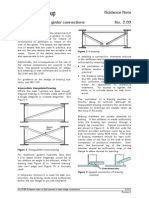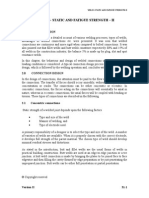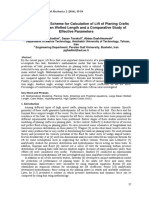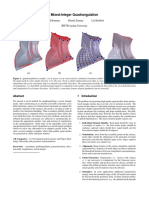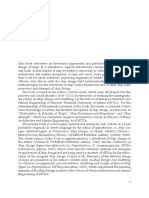Fatigue-Resistant Detail Design Guide For Ship Structures
Fatigue-Resistant Detail Design Guide For Ship Structures
Uploaded by
y_596688032Copyright:
Available Formats
Fatigue-Resistant Detail Design Guide For Ship Structures
Fatigue-Resistant Detail Design Guide For Ship Structures
Uploaded by
y_596688032Original Title
Copyright
Available Formats
Share this document
Did you find this document useful?
Is this content inappropriate?
Copyright:
Available Formats
Fatigue-Resistant Detail Design Guide For Ship Structures
Fatigue-Resistant Detail Design Guide For Ship Structures
Uploaded by
y_596688032Copyright:
Available Formats
B.
6 “GOOD” DESIGN, CONSTRUCTION AND WELDING PRACTICES TO
ENHANCE FATIGUE PERFORMANCE
B.6.1 Introduction
As stated in Section B.2, structural details that are non-critical need only be subject to
good design and fabrication practice to eliminate fatigue cracking. This section provides an
overview of such good practice. The reader is referred to standard ship design and construction
references [e.g., Ref. B.9, B.10] for further reading.
Fatigue cracks in steel ship structures are commonly initiated at weld toes. These cracks
are primarily due to the presence of an initial crack-like defect, a notch or flaw that is also subject
to stress concentrations due to the local weld, and the surrounding structural geometry. The
presence of welding and assembly residual stresses further promotes the initiation of fatigue
cracks. Accordingly, steps should be taken at both the design and construction stages to
minimize these influences, such measures being beneficial in enhancing the fatigue performance
of the affected welds and therefore, of the ship structure.
B.6.2 Detail Design
Because the structural designer responsible for the fatigue performance of a structure may
not be directly involved in the generation of the final fabrication structural drawings, the higher
level, or guidance, drawings must indicate clearly what the assumed or required fabrication
tolerances are. Failure to transmit the important fatigue design data to the fabricator will greatly
reduce the value of much of the process described herein.
An overall goal of good design practice is to minimize stress concentrations. Stress
concentrations occur at the intersection of primary structural members (deck, shell and
longitudinal girders) with other primary structural members, and with secondary structural
members (decks, bulkheads and their stiffeners, etc.). Primary members should be arranged to
ensure effective continuity of strength, and abrupt changes of depth or section should be avoided.
Where members abut on both sides of a bulkhead or other members, proper alignment should be
ensured. Members should have sufficient lateral stability and web stiffening and the structure
should be arranged to minimize “hard-spots” and other sources of stress concentrations.
Members should have sufficient end fixity, through end brackets or equivalent structure, in order
to provide sufficient restraint against rotation and displacement and to provide an effective load
transfer mechanism.
Secondary members are generally connected at their ends. Where a longitudinal
strength member is cut at a primary support and brackets provide the strength continuity, the
bracket scantlings are to be such that the section modulus and effective cross-sectional area are
not less than those of the strength member.
Where openings are to be used, a generous radius should be provided. For large hatch
openings, a corner radius equal to 1/24 of the hatch width, with a minimum radius of 300 mm,
should be used. If the radius must be minimized in order to reduce lost space, appropriate
compensation measures must be taken. Elliptical profiles are also being used more frequently for
hatch corners, large drain holes, etc., as they provide a more favourable stress flow pattern than
radial cuts. For small openings, a radius of 150 mm is generally used.
Fatigue-Resistant Detail Design Guide for Ship Structures B-89
Since there are always stress concentrations around large discontinuities (doors or
hatchways), efforts should be made to avoid lower fatigue design category weld joints (insert
plates, fillet welds, drain holes, etc.) in the vicinity of large openings.
For openings in the webs of stiffeners, the depth of the opening should not exceed 25%
of the web depth. In addition, the opening should ideally be located such that the edges are not
less than 35-40% of the web depth from the face plate. The length of the opening should not
exceed the web depth or 60% of the secondary member spacing, whichever is greater, and the
ends of the openings should be equidistant from the corners of cut-outs for secondary members.
Cut-outs for the passage of secondary members should be designed to minimize stress
concentrations. The breadth of the cut-out should be kept as small as practicable and the top
edge should be rounded, or the corner radii made as large as possible. The direct connection of
the penetrated web plating, or the scantlings of lugs or collars, should be sufficient for the
transmission of lateral loads from the secondary member.
The exceptions to the above Guidelines are the cut-outs, or “ lightening holes”, in double
bottom floor plates and webs where the wide plate web with large cut-out is an improved
alternative to simple stiffeners on the two adjacent structures (e.g., inner and outer shell).
Insert plates, typically used as reinforcement at the corner of a large opening, should be
incorporated into the deck or shell plating. Thick insert plates should be avoided due to their
restraint against weld shrinkage that leads to weld cracks. If necessary, transition strakes should
be inserted to smooth the change in thickness. Doubler plates should be avoided.
Another form of restraint and discontinuity develops when a rigid member abruptly
terminates at the midspan of a flexible plate panel. This creates a hard spot (stress concentration)
in the plate panel, and it is recommended that the terminating rigid member be extended and
tapered to the end of the plate panel.
For the intersection of two planes (i.e., longitudinal bulkhead and deck) where a primary
stress is transferred from one plane to the other, long connection brackets are recommended to
ensure a smooth transfer of stress between the planes.
The toes of brackets, etc., should not land on unstiffened plate panels and the toes should
be concave or tapered.
The use of scallops should be avoided where possible. However, scallops are regularly
used where a groove weld of a stiffener or girder is made after the members have been assembled
in place. Scallops are not recommended for stiffening members, girders or bilge keels in way of
completed shell or deck butts; rather it is recommended that the weld reinforcement be removed
where crossed by the stiffener, girder or bilge keel.
B.6.3 Construction and Welding Practice
Sound construction and welding practice encompasses various aspects such as control of
assembly and fabrication tolerances, selection of joint design, good workmanship, optimum
welding sequence, etc. The welded cruciform joint with load carrying fillet welds is frequently
required in ship fabrication. The fatigue life of such a joint can be drastically reduced by the
presence of misalignment between the load carrying members which are welded to the
continuous member of the joint.
Fatigue-Resistant Detail Design Guide for Ship Structures B-90
The fit-up tolerances typically limit the maximum allowable misalignment, Me, to ts/3 (max. 5
mm), where t is the continuous plate thickness and M is measured from the centrelines of the
intersecting plates (see Figure B.6.3.1). The decrease in fatigue life is proportional to M and
therefore, it is highly desirable to minimize the misalignment.
ts
Me
Continuous
Member
Figure B.6.3.1: Maximum Welded Cruciform Joint Misalignment
Misalignment between two groove-welded members is also detrimental to fatigue life.
Codes and Standards have recognized this and generally limit the maximum misalignment to
10% of the thickness of the thinner member, but no more than 3 mm. For the same reason,
where the difference in plate thickness is greater than 3 mm, the thicker plate should be tapered
(not exceeding 1 in 3) or bevelled to form the welded joint. Where the difference is less than 3
mm, the transition may be achieved within the width of the weld.
Lap connections are typically not used to connect plates that may be subjected to high
tensile or compressive loading. When lap connections are used, the width of the overlap is not to
exceed four times nor be less than three times the thickness of the thinner plate.
Fillet welds are typically used for T-connections and should be on both sides of the
abutting plate. Where the connection is highly stressed, deep penetration or full penetration
welds may be required.
As far as weld joint design is concerned, it is well recognised that fatigue cracks are
relatively easily initiated in transversely loaded partial penetration groove welds and therefore,
full penetration groove welds must be specified when cyclic loading is present. Similarly,
transversely loaded full penetration groove welds made from one side on to a steel backing strip
have a far lower fatigue performance compared to similar welds made from both sides.
However, the ad hoc use of a backing strip to address the problems associated with too large a
root gap during assembly may adversely affect the fatigue strength of the welded joint.
When it comes to member fit-up for fillet welds, it is customary to aim for as small a gap
as possible between the two members. For gaps exceeding 1.6 mm, the required fillet leg length
is increased to compensate for the increased gap. At the same time, there is some evidence that a
gap of 1.5 to 2 mm influences the weld residual stresses in such a way that fatigue performance is
enhanced, provided that the joint restraint is low, i.e., the attaching member is free to move in
response to weld shrinkage [Ref. B.11]. Under such circumstances, a 1.5 mm gap is ideal.
Fatigue-Resistant Detail Design Guide for Ship Structures B-91
Weld shape is another important factor influencing the fatigue performance of the
welded joint. In fillet welds, a slightly convex or slightly concave weld profile is desired.
Excessive convexity is detrimental from a fatigue point of view and is limited in fabrication
codes.
In the case of butt joints, weld reinforcement and undercut are important
considerations. Excessive weld reinforcement increases the stress concentration at the weld toe
and therefore the maximum allowable reinforcement in fabrication codes is typically 3.2 mm
with the weld smoothly blending into the base metal. Undercut, which is defined as a groove or
notch formed in the base metal adjacent to the weld toe, can seriously reduce the fatigue life of
the welded joint. Formed as a result of incorrect selection of welding parameters or welding
consumables, or lack of welder skill, the fabrication codes generally specify smaller allowable
undercut for dynamically loaded structures. For example, Reference B.12 allows a maximum
undercut of 0.25 mm in critical members when the weld is transverse to the applied stress.
Otherwise, the maximum allowed undercut is 0.8 mm (1/32”). In comparison, for statically
loaded structures, the undercut is generally limited to a depth of 1 mm, and for short lengths, the
allowable undercut may be as high as 1.6 mm.
Longitudinal welds generally have good fatigue performance. However, the presence of
starts and stops which are not ground out, or breaks in the backing strip (unwelded joint in
backing strip) in the case of welds made from one side, significantly reduce the fatigue strength
of the weld.
Where stiffening members are continuously fillet welded across completely finished
butt or seam welds, the butt welds are to be made flush. Similarly for the butt welds in the webs
of stiffening members, the butt weld is to be completed and generally made flush with the
stiffening member before the fillet weld is made.
Other welding flaws such as hydrogen-induced cold cracks in the heat affected zone,
solidification cracks in the weld metal, incomplete root penetration in welds made from one side
but without a backing strip, etc., are other likely sites for fatigue crack initiation. Embedded
flaws such as slag inclusions and porosity are relatively benign for fatigue unless present in
excessive amounts.
B.6.4 Residual Stresses
Residual stresses in steel ships can be considered to be composed of two components:
short range weld thermal residual stresses and long range assembly and restraint stresses. The
short range weld thermal residual stresses result in high levels of tensile stresses that approach
the yield strength of the base metal. These residual stresses, which are always present and are
difficult to control or modify, can reduce the fatigue strength of the welded joint. However,
through careful attention to fit-up tolerances and welding sequences, the long range assembly and
restraint stresses can be reduced. If the members to be welded need to be jacked or bent in order
to achieve the correct alignment, bending stresses will be introduced into the structure and these
can contribute to fatigue crack initiation. Once cracking is initiated, these stresses tend to relax.
In terms of welding sequence, it should be so arranged that as welding progresses, the members
retain as much freedom to move as possible.
Fatigue-Resistant Detail Design Guide for Ship Structures B-92
Reference B.9 provides recommendations for welding sequence for butts and seams, with and
without internal framing, and for large sub-assembled plate panels. Another approach is to
commence welding in the deck and bottom regions and progress towards the neutral axis of the
ship. The restraint stresses will then be high near the neutral axis where the applied stresses are
lower.
B.6.5 Weld Toe Dressing Treatments
Finally, it should be added, that in certain situations it may not be possible to avoid
relatively inferior fatigue design details, or the structural detail may involve high stress
concentrations. In these situations, fatigue crack initiation is deemed unavoidable at the design
stage. In such circumstances, one could consider weld toe dressing treatments such as hammer
or shot peening, toe grinding, TIG remelting, etc. Further information on the benefits and costs
of such techniques are covered in Reference B.13.
Fatigue-Resistant Detail Design Guide for Ship Structures B-93
B.8 REFERENCES
[B.1] Ma, K-T., “Tanker Inspection and a Risk-Based approach”, Proceedings of the 8th ISOPE,
Montreal, 1998.
[B.2] Ma, K-T., and Bea, R. G., “Ship Maintenance Project, Phases II and III, Vol. 3, Repair
Management System for Critical Structural Details in Ships”, SSC 395, 1997.
[B.2] “ShipRight - Fatigue Design Assessment Procedure - Structural Detail Design Guide”,
January 1996: Lloyd's Register of Shipping, London.
[B.3] “Guidelines for Surveys, Assessment and Repair of Hull Structure - Bulk Carriers”, IACS,
1994.
[B.4] “Structural Practices Standard for Canadian Forces - Steel Surface Ships”, D-03-002-
008/SG-003, Canadian Department of National Defense DSE, 1993.
[B.5] Germanischer Lloyd, “Rules and Regulations, 1 - Ship Technology, Part 1 - Seagoing
Ships, Chapter 1 - Hull Structures, Hamburg, 1992.
[B.6] Det Norske Veritas, “Rules for Classification of Steel Ships”, DnV Classification A/S,
Norway, 1991.
[B.7] Lloyd’s Register, “Rules and Regulations for the Classification of Ships: Part 3 - Ship
Structure”, 1996.
[B.8] American Bureau of Shipping, Rules for Building and Classing Steel Vessels, 1996.
[B.9] “Guide for Steel Hull Welding”: American Welding Society ANSI/AWS D3.5
[B.10] “Ship Design and Construction”: Taggart: SNAME 1980
[B.11] Johansson, B.G., Kjellander, S.L., and Leide, N.G., “Is it good enough? A study of
tolerances for welded ship structures”, Fitness for Purpose Validation of Welded
Constructions, International Conference, London, UK, 17-19 November, 1981, pp6-1 to
pp6-11.
[B.12] AASHTO 1994. LRFD Bridge Design Specifications, SI Units, First Edition, American
Association of State Highway and Transportation Officials, Washington, DC
[B.13] Kirkhope, K.J., Bell, R., Caron, L, and Basu, R.I., “Weld Detail Fatigue Life
Improvement Techniques”, SSC Report 400, Ship Structure Committee, 1997.
Fatigue-Resistant Detail Design Guide for Ship Structures B-94
You might also like
- BS 7629-1Document20 pagesBS 7629-1floyd hope prieto100% (1)
- Introduction To Interior Design ProcessDocument8 pagesIntroduction To Interior Design ProcessChristone ImmanuelNo ratings yet
- Guide To Joint Design For Welding Ship HullsDocument6 pagesGuide To Joint Design For Welding Ship HullspakzoNo ratings yet
- Comparison of EN 12079 & DNV 2.7-1 - Selected Criteria: Materials MaterialsDocument3 pagesComparison of EN 12079 & DNV 2.7-1 - Selected Criteria: Materials MaterialsDupril Martins100% (1)
- Guidance Note Bracing and Cross Girder Connections No. 2.03: ScopeDocument5 pagesGuidance Note Bracing and Cross Girder Connections No. 2.03: ScopeRaquel CarmonaNo ratings yet
- Weld and BoltDocument31 pagesWeld and BoltNAVEENABNNo ratings yet
- Guidance Note Bracing Systems No. 1.03: ScopeDocument4 pagesGuidance Note Bracing Systems No. 1.03: ScopeRaquel CarmonaNo ratings yet
- Plate GirdersDocument9 pagesPlate GirdersTapabrata2013No ratings yet
- Mat Chapter 31Document27 pagesMat Chapter 31hemant_durgawaleNo ratings yet
- Prying Forces in The Bolts Become Significant When Ninety Percent of The YieldDocument2 pagesPrying Forces in The Bolts Become Significant When Ninety Percent of The YieldRC Dela RocaNo ratings yet
- Lesson 4EDocument61 pagesLesson 4Ecode.faith.17No ratings yet
- CONEXÃODocument2 pagesCONEXÃORui GavinaNo ratings yet
- Concrete Rules of ThumbDocument8 pagesConcrete Rules of Thumbdeekchik121No ratings yet
- 7 Truss BridgesDocument10 pages7 Truss Bridges0808276kNo ratings yet
- Reinforcement Detailing For Openings in Beams 103Document5 pagesReinforcement Detailing For Openings in Beams 103stefengoNo ratings yet
- Plate Girder Behaviour and DesignDocument48 pagesPlate Girder Behaviour and DesignayingbaNo ratings yet
- Lec 5 CE 806 RCM Development, Anchorage and Splicing of ReinforcementDocument69 pagesLec 5 CE 806 RCM Development, Anchorage and Splicing of ReinforcementwasimkhaliqNo ratings yet
- Paper Reinforced Concrete SlabsDocument32 pagesPaper Reinforced Concrete SlabsTHRESNANo ratings yet
- GN - 2 05 SecureDocument0 pagesGN - 2 05 SecureCatalin CataNo ratings yet
- Slabs FinalDocument30 pagesSlabs FinalMwa100% (3)
- 2lec3&4 With Assignment 2 Reinf Conc 412Document42 pages2lec3&4 With Assignment 2 Reinf Conc 412Emmanuel MwabaNo ratings yet
- Preliminary Design Rules of ThumbDocument11 pagesPreliminary Design Rules of Thumbnimal1234No ratings yet
- TB Lecture20 Example of PT Two Way SlabsDocument39 pagesTB Lecture20 Example of PT Two Way SlabsBridget Anne BenitezNo ratings yet
- Flat SlabsDocument11 pagesFlat SlabsSingamaneni PardhuNo ratings yet
- STRL Design Rules of Thumb PDFDocument11 pagesSTRL Design Rules of Thumb PDFsakti prasanna sahuNo ratings yet
- Control of Shrinkage and Curling in Slabs On Grade: Part 3 of A 3-Part SeriesDocument4 pagesControl of Shrinkage and Curling in Slabs On Grade: Part 3 of A 3-Part Seriesmyke_0101No ratings yet
- Opening in 2 Way SlabDocument4 pagesOpening in 2 Way SlabGautam PaulNo ratings yet
- TN011Document14 pagesTN011HeirwireNo ratings yet
- C I 3304 Detailing CornerDocument5 pagesC I 3304 Detailing CornerNono_geotecNo ratings yet
- Seccion 16 Abs SoldaduraDocument9 pagesSeccion 16 Abs SoldaduraRoberto DavilaNo ratings yet
- Lecture 7-Plate GirdersDocument44 pagesLecture 7-Plate GirdersBaraka GotoraNo ratings yet
- Plate Girder Behaviour and Design I: ObjectiveDocument48 pagesPlate Girder Behaviour and Design I: ObjectiveSachin MNo ratings yet
- AD 331 - Open Top Box Girders For BridgesDocument2 pagesAD 331 - Open Top Box Girders For Bridgessymon ellimacNo ratings yet
- Rules of ThumbDocument14 pagesRules of ThumbAntoniette Samantha Nacion100% (1)
- RCC Member Design TipsDocument9 pagesRCC Member Design TipsNaren ViratNo ratings yet
- Section3 Unit3Document10 pagesSection3 Unit3jbsNo ratings yet
- Or Less: How To Determine The Best Connections For Steel Joists and Metal DeckDocument4 pagesOr Less: How To Determine The Best Connections For Steel Joists and Metal DeckMinh Tâm TrầnNo ratings yet
- Antiseismic StirrupsDocument24 pagesAntiseismic StirrupsmarNo ratings yet
- Laced and Battened Columns, Design of Steel ColumnDocument14 pagesLaced and Battened Columns, Design of Steel ColumnRaju Sharma80% (30)
- Simple Shear ConnectionsDocument3 pagesSimple Shear ConnectionsMena M. ZakiNo ratings yet
- Opening in Slab and BeamDocument13 pagesOpening in Slab and BeamYohan LimNo ratings yet
- Classification of Sections.Document6 pagesClassification of Sections.rahulnagwe003No ratings yet
- Reinforcing Steel in Slabs On Grade - tcm45-346883Document3 pagesReinforcing Steel in Slabs On Grade - tcm45-346883Ralf SnellNo ratings yet
- Joining Methods: Tolerances: Fit Between PartsDocument11 pagesJoining Methods: Tolerances: Fit Between PartsChiara RipaltiNo ratings yet
- Splices and Other Connections in BridgesDocument10 pagesSplices and Other Connections in BridgesPankaj_Taneja_9684No ratings yet
- Technical Advisory Slab PAVEMENTDocument6 pagesTechnical Advisory Slab PAVEMENTNoli PaladNo ratings yet
- Railway Bridge Design Assessment - Design of Plate Girders-1Document79 pagesRailway Bridge Design Assessment - Design of Plate Girders-1Mohamed ShabibNo ratings yet
- Lesson 2-1Document99 pagesLesson 2-1code.faith.17No ratings yet
- Practice For Mounting Buses & Joints-374561Document11 pagesPractice For Mounting Buses & Joints-374561a_sengar1No ratings yet
- Spacing of Rebars Steel Bars 1Document4 pagesSpacing of Rebars Steel Bars 1talatzahoor0% (1)
- Bracing Systems - SteelConstruction - InfoDocument17 pagesBracing Systems - SteelConstruction - Infolovepreet singhNo ratings yet
- Chevron Bracing Details - SteelwiseDocument4 pagesChevron Bracing Details - SteelwiseEugene Afable100% (1)
- Lecture 3 & 4 Structural Steel Design MuDocument26 pagesLecture 3 & 4 Structural Steel Design MuPenelope MalilweNo ratings yet
- Elated Worked ExamplesDocument24 pagesElated Worked ExamplesNaturinda SarahNo ratings yet
- Built Up ColumnsDocument28 pagesBuilt Up ColumnsSuneesh PNo ratings yet
- Control of Flexural Cracks by Jack C. McCormacDocument9 pagesControl of Flexural Cracks by Jack C. McCormacbig_one214No ratings yet
- Web Openings in Composite Beams: Steel Industry Guidance NotesDocument2 pagesWeb Openings in Composite Beams: Steel Industry Guidance Notesizia_2No ratings yet
- Structural TipsDocument7 pagesStructural Tipsbalacr3No ratings yet
- PCA Concrete Floor Slab OpeningsDocument4 pagesPCA Concrete Floor Slab OpeningsRavindra MRNo ratings yet
- Bolted Flanged Joint: Flanges, Studs & Gaskets. Recommended Practices for the Assembly of a Bolted Flange Joint.From EverandBolted Flanged Joint: Flanges, Studs & Gaskets. Recommended Practices for the Assembly of a Bolted Flange Joint.No ratings yet
- Fatigue-Resistant Detail Design Guide For Ship StructuresDocument79 pagesFatigue-Resistant Detail Design Guide For Ship Structuresy_596688032No ratings yet
- B.5.2 Bulk Carrier Structure Details: Figure B.5.2: Typical Midship Section Nomenclature For Bulk CarriersDocument56 pagesB.5.2 Bulk Carrier Structure Details: Figure B.5.2: Typical Midship Section Nomenclature For Bulk Carriersy_596688032No ratings yet
- Ship Operations in Cold Climate: DNV MaritimeDocument4 pagesShip Operations in Cold Climate: DNV Maritimey_596688032No ratings yet
- A Mathematical Scheme For Calculation of Lift of Planing Crafts With Large Mean Wetted Length and A Comparative Study of Effective ParametersDocument20 pagesA Mathematical Scheme For Calculation of Lift of Planing Crafts With Large Mean Wetted Length and A Comparative Study of Effective Parametersy_596688032No ratings yet
- Mixed-Integer Quadrangulation: David Bommes Henrik Zimmer Leif Kobbelt RWTH Aachen UniversityDocument10 pagesMixed-Integer Quadrangulation: David Bommes Henrik Zimmer Leif Kobbelt RWTH Aachen Universityy_596688032No ratings yet
- DNV Supports The Tanker IndustryDocument4 pagesDNV Supports The Tanker Industryy_596688032No ratings yet
- Mixed-Integer Quadrangulation: David Bommes Henrik Zimmer Leif Kobbelt RWTH Aachen UniversityDocument10 pagesMixed-Integer Quadrangulation: David Bommes Henrik Zimmer Leif Kobbelt RWTH Aachen Universityy_596688032No ratings yet
- Finding The Hull Form For Given Seakeeping Characteristics PDFDocument8 pagesFinding The Hull Form For Given Seakeeping Characteristics PDFy_596688032No ratings yet
- Parametric Rolling at Main Resonance: Dan Obreja Radoslav NABERGOJ Liviu CRUDU Sandita PACURARU (Popoiu)Document8 pagesParametric Rolling at Main Resonance: Dan Obreja Radoslav NABERGOJ Liviu CRUDU Sandita PACURARU (Popoiu)y_596688032No ratings yet
- 2313Document4 pages2313y_596688032No ratings yet
- T1 Ikits: - Kefs Leebikmsi Information AgencyDocument51 pagesT1 Ikits: - Kefs Leebikmsi Information Agencyy_596688032No ratings yet
- Improving Propeller Efficiency Through Tip Loading: NOVEMBER 2014Document18 pagesImproving Propeller Efficiency Through Tip Loading: NOVEMBER 2014y_596688032No ratings yet
- Creating Clone Database Using RMAN On Another ServerDocument9 pagesCreating Clone Database Using RMAN On Another ServerSHAHID FAROOQNo ratings yet
- Building Estimate NewDocument40 pagesBuilding Estimate Newgolu23_1988No ratings yet
- Internal Follow UpDocument69 pagesInternal Follow UpSahil BhagatNo ratings yet
- PSR Addendum - Part2 - PonDocument41 pagesPSR Addendum - Part2 - PonshravanaNo ratings yet
- v1 AB3737-L Aubin Families-IntroDocument36 pagesv1 AB3737-L Aubin Families-IntroAnonymous WXJTn0No ratings yet
- IT Data-Center Facilities Manager/Asset Management Hardware TechDocument2 pagesIT Data-Center Facilities Manager/Asset Management Hardware Techapi-121445894No ratings yet
- Digigov - 2024-05-30T115206.302Document1 pageDigigov - 2024-05-30T115206.302visitsheetrajkotNo ratings yet
- IsometricDocument29 pagesIsometricMOHAMMAD ASIFNo ratings yet
- Iannis Xenakis - Musique StochastiqueDocument14 pagesIannis Xenakis - Musique StochastiquevillaandreNo ratings yet
- Project of Wall PuttyDocument4 pagesProject of Wall PuttyVineet MishraNo ratings yet
- Consultancy Tender - Document Warangal 10 Court BuildingDocument43 pagesConsultancy Tender - Document Warangal 10 Court BuildingDaya Kiran100% (1)
- DocumentoDocument33 pagesDocumentoMaria AlvaradoNo ratings yet
- HP MSM775 ZL Controller Installation GuideDocument21 pagesHP MSM775 ZL Controller Installation GuidezarandijaNo ratings yet
- TIBCO Hawk Rulebase Standard GuidelinesDocument9 pagesTIBCO Hawk Rulebase Standard GuidelinesAshish ShrivastavaNo ratings yet
- Computer Assignment: Name: Suman Mahapatra Class: X Section: B Roll. No: 14 TOPIC: World Wide Web &web SiteDocument4 pagesComputer Assignment: Name: Suman Mahapatra Class: X Section: B Roll. No: 14 TOPIC: World Wide Web &web SiteAmalendu Sundar MandalNo ratings yet
- Huawei Realtests H12-211 v2015-01-21 by Connor 233qDocument53 pagesHuawei Realtests H12-211 v2015-01-21 by Connor 233qJoffre Ramiro Pesantez VerdezotoNo ratings yet
- Masonry Wall Design Rule in RISADocument5 pagesMasonry Wall Design Rule in RISAkirubaNo ratings yet
- FSED 006 Fire Safety Checklist 07aug2018Document2 pagesFSED 006 Fire Safety Checklist 07aug2018Romel RagasaNo ratings yet
- Shear and Diagonal TensionDocument21 pagesShear and Diagonal TensionJohnvirgo Corpuz0% (1)
- Rehabilitation Centre Groot Klimmendaal by Architectenbureau Koen Van VelsenDocument9 pagesRehabilitation Centre Groot Klimmendaal by Architectenbureau Koen Van Velsenarchpavlovic100% (1)
- Basf Masterlife Ci 222 TdsDocument2 pagesBasf Masterlife Ci 222 TdsAnonymous ouZFaSBRNo ratings yet
- Astm E241Document14 pagesAstm E241Lupita Ramirez100% (1)
- Guidelines For Inspection and Maintenance of Bridges Vol.2 - Minor Repairs (Recurrent Maintenance)Document111 pagesGuidelines For Inspection and Maintenance of Bridges Vol.2 - Minor Repairs (Recurrent Maintenance)anjan luitelNo ratings yet
- Detailing of Reinforcement in Concrete StructuresDocument82 pagesDetailing of Reinforcement in Concrete StructuresLarissa100% (2)
- Ccnpv6 Tshoot Sba Stud ExamDocument9 pagesCcnpv6 Tshoot Sba Stud ExamSebastien CamatNo ratings yet
- Tiva TM4C1233H6PM Microcontroller: (Identical To LM4F120H5QR)Document1,202 pagesTiva TM4C1233H6PM Microcontroller: (Identical To LM4F120H5QR)mordiscoverdeNo ratings yet
- Garden LightsDocument1 pageGarden LightscarylNo ratings yet




